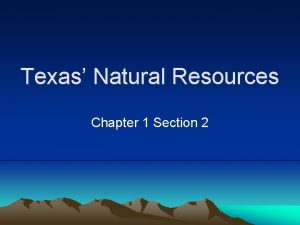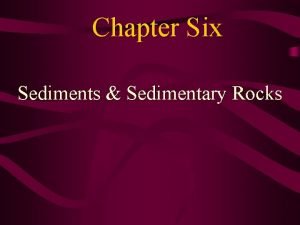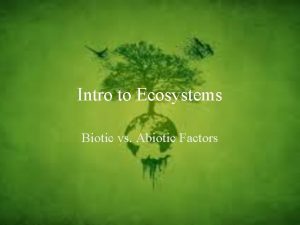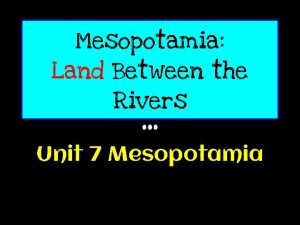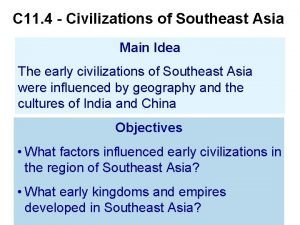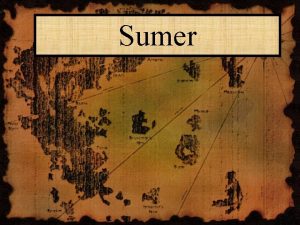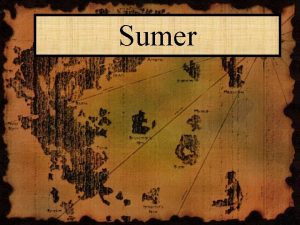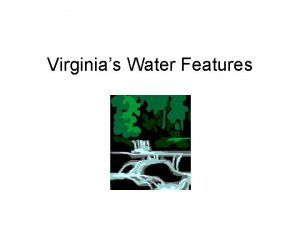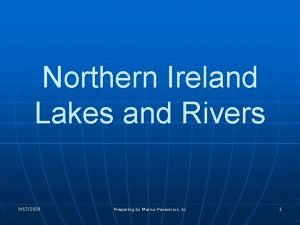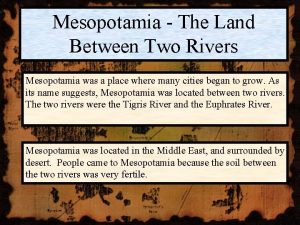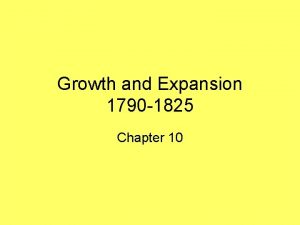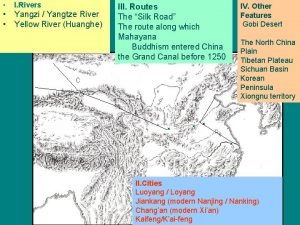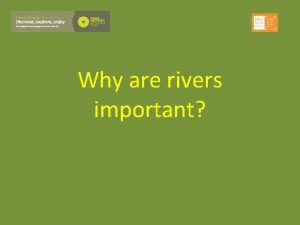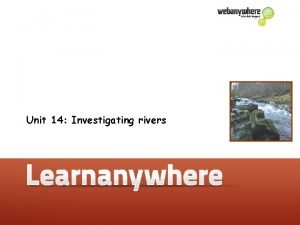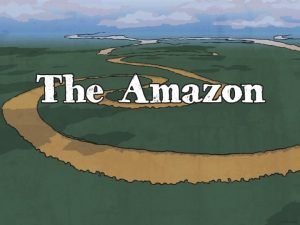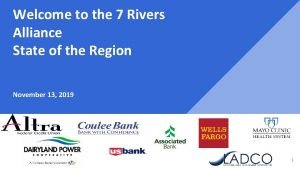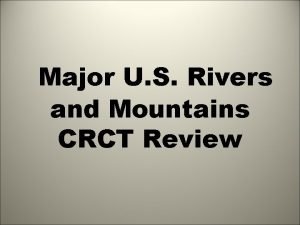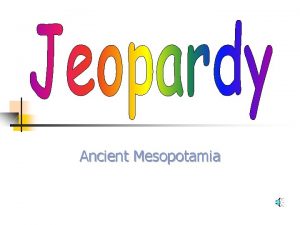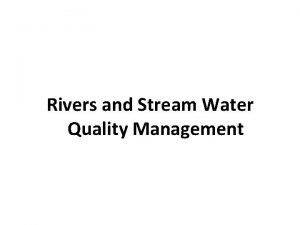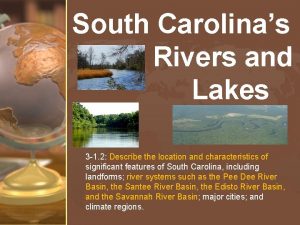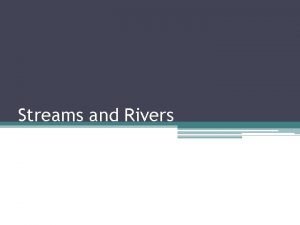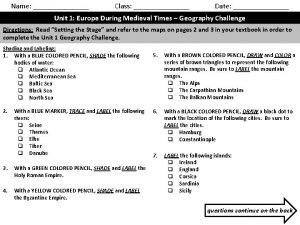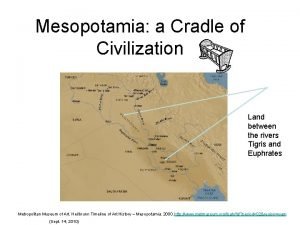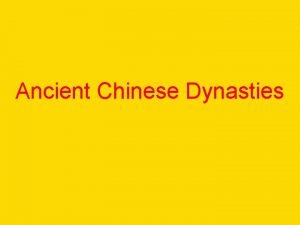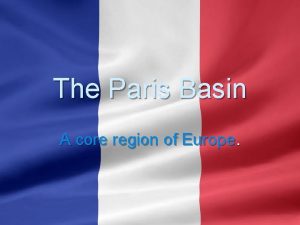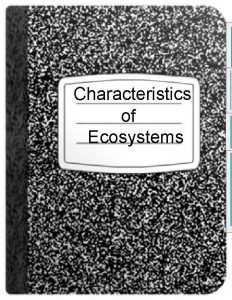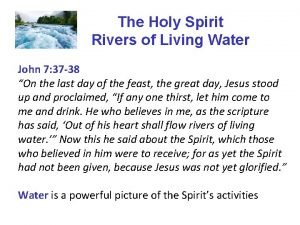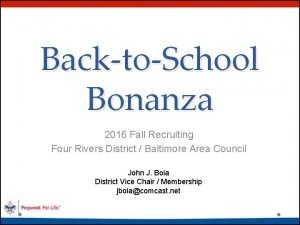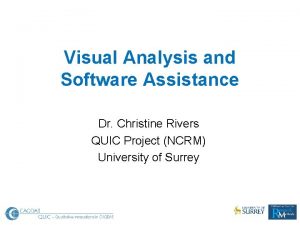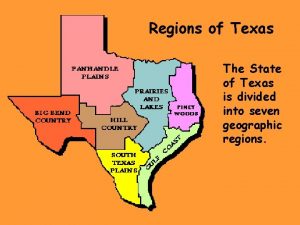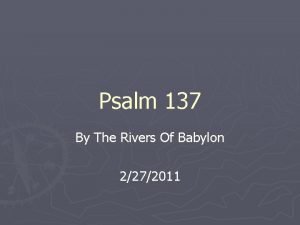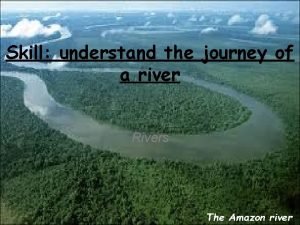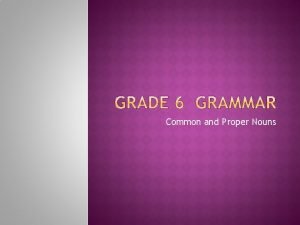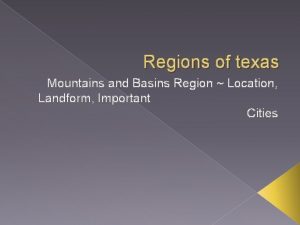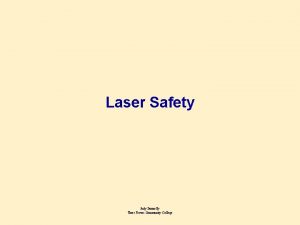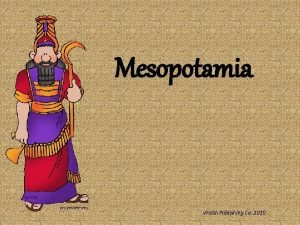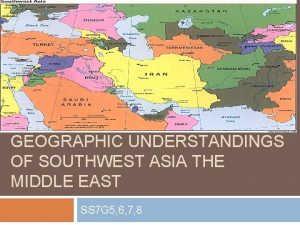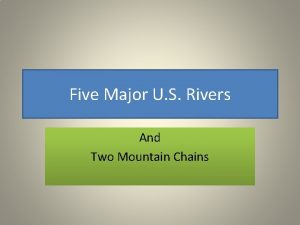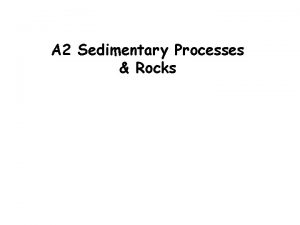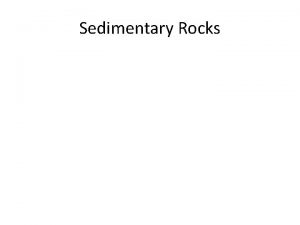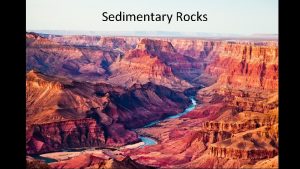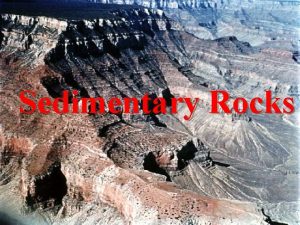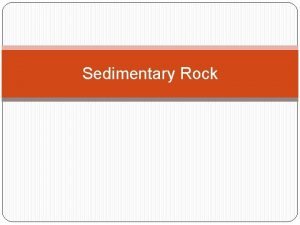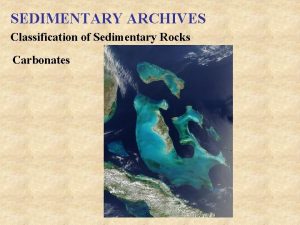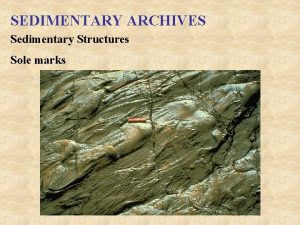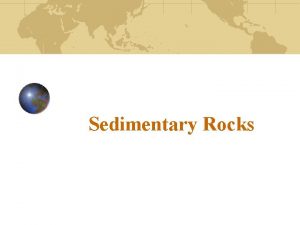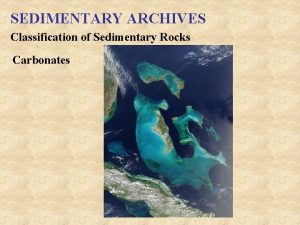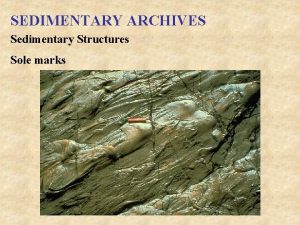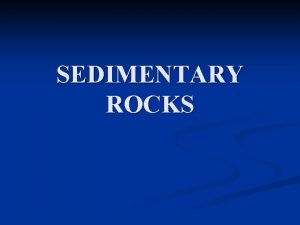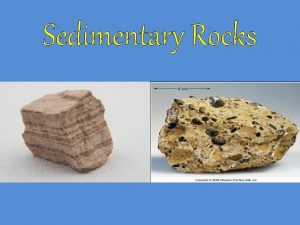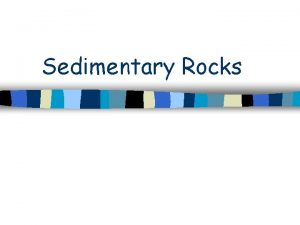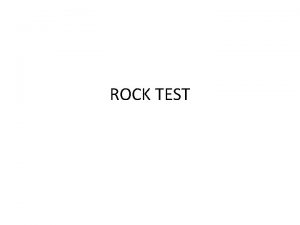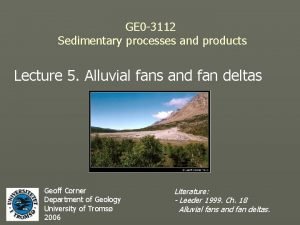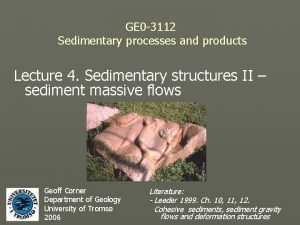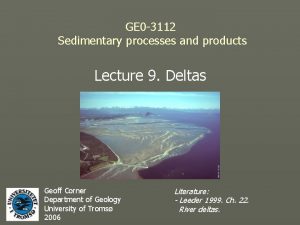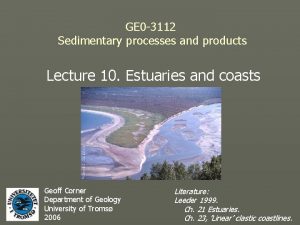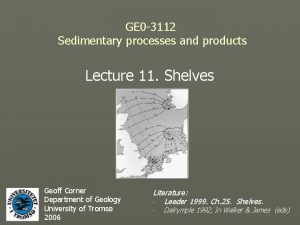Rivers GEO3112 2006 GE 0 3112 Sedimentary processes



















































- Slides: 51

Rivers GEO-3112 2006 GE 0 -3112 Sedimentary processes and products Lecture 6. Rivers Geoff Corner Department of Geology University of Tromsø 2006 Literature: - Leeder 1999. Ch. 17. Rivers.

Rivers GEO-3112 2006 Contents ► 6. 1 Introduction – importance of fluvial systems ► 6. 2 Fluvial channels ► 6. 3 Floodplains ► 6. 4 Fluvial architecture

Rivers GEO-3112 2006 Importance of fluvial systems ► 1) Rivers are major erosive and sediment transport agents. ► Fluvial sediments are mostly transient but may form thick deposits in several settings. ► Fluvial deposits are sensitive palaeoenvironment indicators.

Rivers GEO-3112 2006 ► 1) Rivers are : § erosive agents § conduits for sediment transport to lacustrine and marine basins.

Rivers GEO-3112 2006 ► 2) Fluvial sediments are mostly transient but form thick deposits in several settings: § coastal plains § intermontane basins § tectonic forelands Modern and Holocene terraced fluvial deposits at Tana, N. Norway.

Rivers GEO-3112 2006 ► 3) Fluvial deposits are sensitive palaeoenvironment indicators: § tectonic slope changes § sourceland geology § climate § sea-level change Postglacial fluvial terraces at Porsanger, N. Norway

Rivers GEO-3112 2006 Fluvial channels ► Size and gradient ► Shape (form) ► Processes ► Bedforms and internal structures

Rivers GEO-3112 2006 Bankfull width ► Channel size is measured as bankfull width. Channel width Normal Bankfull

Rivers GEO-3112 2006 Channel size ► Size varies by four orders of magnitude: § <2 m (small streams) § >20 km (Brahmaputra, Ganges).

Rivers GEO-3112 2006 Channel size vs. discharge Channel width Discharge Q = whu Channel depth Mean flow velocity ► Discharge increases with increasing width, depth and velocity. ► Discharge, width, depth and velocity all increase downstream.

Rivers GEO-3112 2006 Width vs depth ► Depth (h) increases with increasing width (w). ► W/h ratios are higher in low-sinuosity rivers. High sinuosity (low w/h ratios) Low sinuosity (high w/h ratios) NB: Symbols erroneously reversed

Rivers GEO-3112 2006 Long profile ► Downstream changes (in effluent streams): § Discharge increases. § Gradient decreases (the flow is more efficient; with increased discarge the gradient must decrease to maintain equilibrium). Graded river: concave longprofile.

Rivers Downstream changes: Amazon R. GEO-3112 2006

Rivers W Tectonic disturbance of river profiles across the Himalayan front. E GEO-3112 2006

Rivers GEO-3112 2006 Channel shape ► Parameters shape: for describing channel planform § Sinuosity (P) § Braiding § Anastomosing Channel types illustrating characteristics of sinuosity, braiding and anastomosing (Galloway & Hobday 1996).

Rivers ► Sinuosity GEO-3112 2006

Rivers ► Braiding GEO-3112 2006

Rivers ► Anastomosing GEO-3112 2006

Rivers GEO-3112 2006 Controls on channel shape ► Sediment load ► Stream power ► Bank stability

Rivers GEO-3112 2006 Braiding on sandy substrate Meandering on clayey substrate

Rivers GEO-3112 2006 Meandering Channel variability Braided Gandak River, Nepal-India

Rivers GEO-3112 2006 River confluences Deep scour at confluences. ► May be several times deeper than contributing tributaries. ► Mobile scour-and-fill units at the base of a succession. ►

Rivers GEO-3112 2006 Scour pool Jamuna-Ganges confluence, Bangladesh, 1993 -96. Recent scours Infilled scour

Rivers Depositional architecture and stacking patterns Masjok, Tana GEO-3112 2006

Rivers GEO-3112 2006 Channel sediment transport and bedforms ► bars (macrofoms) Point bar ► dunes Mid-channel bar ► ripples Side bar Dunes

Rivers GEO-3112 2006 Point bars and meanders ► Helical flow around a meander bend

Rivers GEO-3112 2006 Point bar deposits Scroll bars Lateral accretion (epsilon cross-stratification)

Rivers GEO-3112 2006 Fluvial point-bar depoits in the Spanish Pyrenees

Rivers ► Fining-upward point-bar successions GEO-3112 2006

Rivers GEO-3112 2006 Channel bars ► Diffluence and confluence ► Downstream accretion

Rivers GEO-3112 2006

Rivers GEO-3112 2006 Linguoid dunes, Tana Planar cross-bedded unit with sigmoidal foresets (dune bedding), Tana

Rivers GEO-3112 2006

Rivers GEO-3112 2006 Braided river succession, Masjok, Tana

Rivers GEO-3112 2006 Anastomosing channels ► Vertical accretion dominates

Rivers GEO-3112 2006 Floodplain ► Important processes: § Overbank flooding § Intermittent avulsion

Rivers GEO-3112 2006 Floodplain deposits ► Vertical accretion of overbank muds and organic sediment. ► Lateral accretion on levees and crevasse splays.

Rivers GEO-3112 2006 Avulsion site, c. 1870 Cumberland Marshes avulsion, Saskatchewan R.

1945 Rivers GEO-3112 2006 1977 Changes 1945 - 1977

Rivers GEO-3112 2006 Crevasse splays Galloway & Hobday 1996

Rivers GEO-3112 2006

Rivers GEO-3112 2006

Rivers GEO-3112 2006 Avulsion and channel belts ► Sudden shift in channel reach (bend cutoff) or whole channel belt. ► Controlled by internal (autocyclicity) or external factors (base-level, climate, tectonics). ► Diversion more likely during extreme flood events or fault movement.

Rivers GEO-3112 2006 Channel belts Palaeochannels of the Holocene Rhine-Meuse. Stacking patterns – fluvial architecture.

Rivers GEO-3112 2006 Incision – aggradation cycles ► Regional cycles of incision and aggradation may occur on the scale of decades or more. ► Causes may be ’intrinsic’ or extrinsic, e. g: § water and sediment discharge variations controlled by climate and catchment characteristics (e. g. ENSO). § eustatic sea level changes. § tectonics.

Rivers GEO-3112 2006 Fluvial incision and knickpoints ► Fall in relative sea-level causes upstream knickpoint migration.

Rivers Depositional architecture and stacking patterns GEO-3112 2006

Rivers Depositional architecture and stacking patterns at Tana Masjok, Tana GEO-3112 2006

Rivers GEO-3112 2006 Fluvial architecture

Rivers GEO-3112 2006 Ancient fluvial deposits

Rivers GEO-3112 2006 Further reading ► Cf. Colloquim literature on fluvial deposits.
 Why are some rivers in texas called “wrong way” rivers?
Why are some rivers in texas called “wrong way” rivers? Loose solid particles
Loose solid particles Concurrent processes are processes that
Concurrent processes are processes that Is a tree biotic
Is a tree biotic Mesopotamia land between two rivers
Mesopotamia land between two rivers Se asia rivers
Se asia rivers How to describe a river
How to describe a river 2 rivers in mesopotamia
2 rivers in mesopotamia Diagram of rivers
Diagram of rivers Gcwak
Gcwak City between two rivers
City between two rivers Important water features of virginia
Important water features of virginia Longest river in northern ireland
Longest river in northern ireland Scribes
Scribes Profited from location on major rivers
Profited from location on major rivers I rivers
I rivers Only when all the rivers have run dry
Only when all the rivers have run dry Lateral thinking riddle
Lateral thinking riddle Why are rivers important
Why are rivers important Investigating rivers
Investigating rivers Rivers passing through sherwood forest
Rivers passing through sherwood forest Jorge beltran la crosse
Jorge beltran la crosse Major us rivers
Major us rivers What 2 rivers surround mesopotamia
What 2 rivers surround mesopotamia Rivers
Rivers South carolina major rivers
South carolina major rivers Land between two rivers
Land between two rivers Different bodys of water
Different bodys of water Label the seine thames elbe tiber and danube rivers
Label the seine thames elbe tiber and danube rivers Cradles of civilization map
Cradles of civilization map Rivers title page
Rivers title page Rivers knowledge organiser
Rivers knowledge organiser Mesopotamia 2 rivers
Mesopotamia 2 rivers Three august ones
Three august ones Sketch map of paris basin
Sketch map of paris basin Bill nye rivers and streams answers
Bill nye rivers and streams answers Holy spirit rivers of living water
Holy spirit rivers of living water Four rivers district
Four rivers district Label it
Label it Which software
Which software 7 regions of texas
7 regions of texas Psalms by the rivers of babylon
Psalms by the rivers of babylon Journey of river
Journey of river Proper noun for city
Proper noun for city Texas regions mountains and basins
Texas regions mountains and basins Jane eyre sinjin
Jane eyre sinjin 3 rivers optical
3 rivers optical Two rivers in mesopotamia
Two rivers in mesopotamia What rivers run through iraq
What rivers run through iraq Major us rivers
Major us rivers River symbolism
River symbolism 3 rivers indian clinic muskogee
3 rivers indian clinic muskogee
